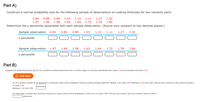
A First Course in Probability (10th Edition)
10th Edition
ISBN: 9780134753119
Author: Sheldon Ross
Publisher: PEARSON
expand_more
expand_more
format_list_bulleted
Concept explainers
Topic Video
Question
Please help with both parts a and b

Transcribed Image Text:Part A)
Construct a normal probability plot for the following sample of observations on coating thickness for low-viscosity paint.
0.84
0.86
0.89
1.03
1.10
1.11
1.27
1.32
1.47
1.49
1.58
1.63
1.64
1.72
1.78
1.84
Determine the z percentile associated with each sample observation. (Round your answers to two decimal places.)
Sample observation
0.84
0.86
0.89
1.03
1.10
1.11
1.27
1.32
z percentile
Sample observation
1.47
1.49
1.58
1.63
1.64
1.72
1.78
1.84
z percentile
Part B)
Suppose the sediment density (g/cm) of a randomly selected specimen from a certain region is normally distributed with mean 2.66 and standard deviation 0.78.
A USE SALT
(a) If a random sample of 25 specimens is selected, what is the probability that the sample average sediment density is at most 3.00? Between 2.66 and 3.00? (Round your answers to four decimal places.)
at most 3.00
between 2.66 and 3.00
(b) How large a sample size would be required to ensure that the first probability in part (a) is at least 0.99? (Round your answer up to the nearest whole number.)
specimens
Expert Solution
This question has been solved!
Explore an expertly crafted, step-by-step solution for a thorough understanding of key concepts.
This is a popular solution
Trending nowThis is a popular solution!
Step by stepSolved in 3 steps

Knowledge Booster
Learn more about
Need a deep-dive on the concept behind this application? Look no further. Learn more about this topic, probability and related others by exploring similar questions and additional content below.Similar questions
- Part c looks incomplete. Can it be reviewed please.arrow_forwardWhat will the independent variable, x, represent?arrow_forwardArrange these steps in the correct order to prove that if you have an 8-gallon jug of water and two empty jugs with capacities of 5 gallons and 3 gallons, respectively, then you can measure 4 gallons by successively pouring some of or all of the water in a jug into another jug in the correct order. Rank the options below. Fill the 3-gallon jug from the 5-gallon jug, leaving (3, 2, 3). Empty the 5-gallon jug's contents into the 3-gallon jug, leaving (6, 0, 2), and then fill the 5-gallon jug from the 8-gallon jug, producing (1, 5, 2). Fill the 5-gallon jug from the 8-gallon jug, leaving the contents (3, 5, 0), where the ordered triple is used to record the amount of water in the 8-gallon jug, the 5-gallon jug, and the 3-gallon jug, respectively. Top off the 3-gallon jug from the 5-gallon jug, and there will be (1, 4, 3), with four gallons in the 5-gallon jug. Pour the contents of the 3-gallon jug back into the 8-gallon jug, leaving (6, 2, 0). ❤ ← ←arrow_forward
arrow_back_ios
arrow_forward_ios
Recommended textbooks for you
 A First Course in Probability (10th Edition)ProbabilityISBN:9780134753119Author:Sheldon RossPublisher:PEARSON
A First Course in Probability (10th Edition)ProbabilityISBN:9780134753119Author:Sheldon RossPublisher:PEARSON

A First Course in Probability (10th Edition)
Probability
ISBN:9780134753119
Author:Sheldon Ross
Publisher:PEARSON
